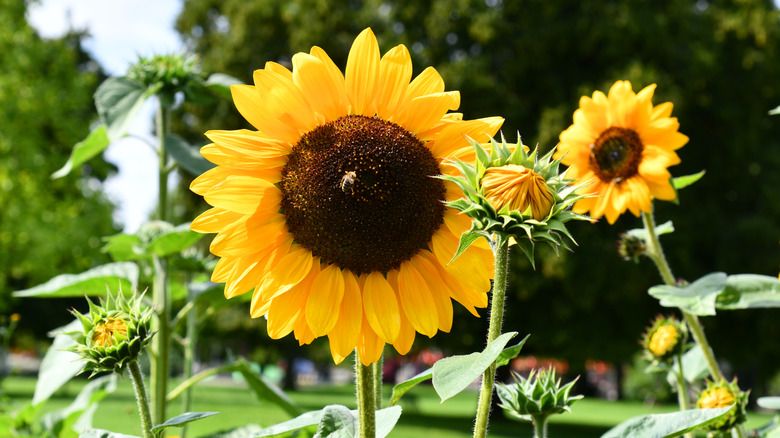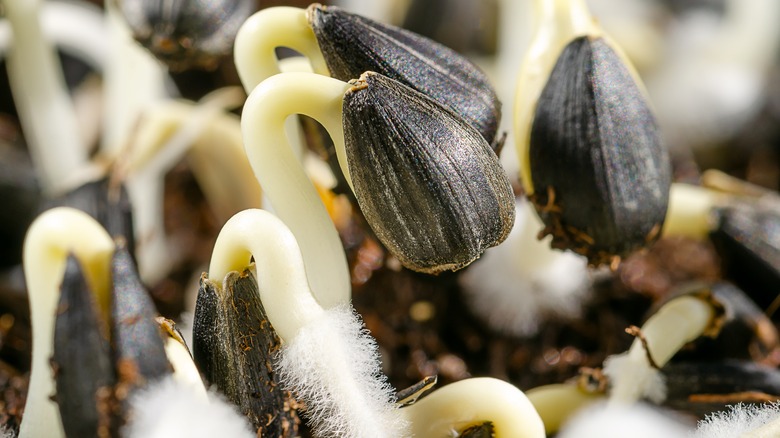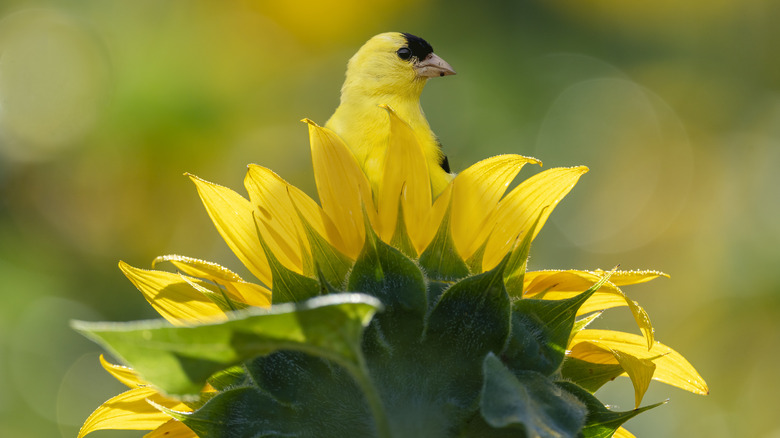The Best Sunflower Varieties For Attracting Birds To Your Garden
Sunflowers (Helianthus annuus) are not only a lovely addition to your yard, but provide a fulfilling buffet for your bird-friendly garden. Pollinators, including bees, butterflies, lacewings, and parasitic wasps, love them for their sweet nectar. And their seeds are an abundant source of food for birds year-round. Sunflower heads can get up to 12 inches in diameter and produce between 1,000 and 2,000 seeds per head. While not all varieties of sunflowers are equally attractive to birds, black oil sunflowers, striped sunflowers, and dwarf sunflowers are varieties of sunflowers you can plant in your garden to allure your feathered friends.
Black oil sunflowers are the preference for most birds due to their small, thin hulls, making the inner meat accessible even to small birds. They also have the most oil content, which is useful for winter birds who use it to coat their feathers to protect against the cold. The striped sunflower has bigger, striped seeds that have a slightly thicker shell that will attract specific birds like cardinals, chickadees, and doves with the beak to crack it. Dwarf sunflowers are perfect if you have a small yard or garden but still want stunning flowers that will brighten your property. The sunflowers can grow in containers and get between 2 and 3 feet tall. They are favored by smaller birds like finches, and despite their size, they still provide a considerable amount of seeds.
Growing your sunflowers with care
Since sunflowers are native to North America, they are quite easy to grow. They also tolerate the heat rather well and are tough enough to withstand most pests like aphids and ants. Sunflowers are heliotropic and direct their bright flower heads, before they're full of seeds, towards the sun, following its movement throughout the day. If you're growing a particularly large variety of sunflower that produces a lot of seeds for the birds, then you'll want to give them plenty of space to keep them from towering over other plants in your garden.
Starting sunflowers from seeds is an inexpensive way to grow them. You can get them underway indoors in biodegradable pots so that they're ready to transplant in spring after the last frost. Otherwise, wait until the risk of frost is over to seed them outside. Well-draining soil and light fertilizer will help them develop strong roots. As they grow, you can help support their stalks with bamboo stakes to keep them from blowing over in your garden. You can grow different varieties of sunflowers to support birds year-round, depending on when certain varieties bloom and develop their seeds. Dwarf varieties typically flower early, towards the end of June. Other varieties will bloom picture-perfect sunflowers later in fall. From seed to flower it can take around 80 to 120 days for sunflowers to bloom.
Sunflower-loving birds
Many species of birds love sunflowers. They also enjoy snacking on the insects the sunflowers attract and use the plant materials for their nests. Many birds, including finches, buntings, siskins, cardinals, and woodpeckers will eat the seeds right out of the flower. If you don't like the look of the dry, dead, or dying sunflowers in your garden, you can cut the heads and let them dry out separately. Then you can tie them up as bird feeders throughout the fall and winter. Or you can hang them near your existing bird feeders as an additional treat. Some varieties will reseed themselves and grow into new sunflower plants the following year, so be sure to put them in an area where you don't mind having sunflowers spring up in your garden.
Planting sunflowers, however, is one small part of attracting birds to your garden. It's important to learn more about the surrounding environment and the birds in your area so you know how to impart a suitable space for them. Providing native plants, fruit trees, and other seed-producing perennials can promote drawing in more birds and insects that birds like to eat. Sunflowers are known to provide habitats that attract migratory birds which help keep unwanted pests down to a minimum and can reduce reliance on pesticides, too. Water is another resource you'll want to supply that birds rely on. A bird bath, hollowed-out boulders, or DIY water features you can add are very appealing. Planting sunflowers and providing an ideal habitat will have birds flocking into your garden year-round.


